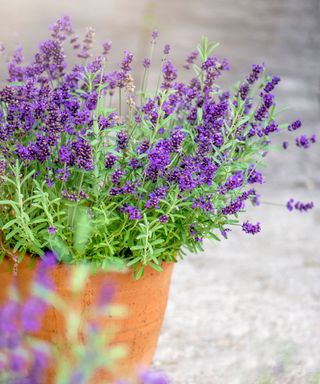Pollinator plants play a vital role in a thriving backyard ecosystem. Flowers rich in pollen feed and support a multitude of bees, butterflies and other beneficial insects. While wildflower beds and naturalized meadows gain popularity, gardeners with smaller green spaces can still create a potted pollinator garden capable of attracting a host of beneficial winged friends.
Fortunately, there is a wide array of small pollinator plants that grow well in raised beds, hanging baskets and containers. Learning more about these flower types can help you create a pollinator container garden that looks lovely, attracts bees and butterflies. These small space pollinator garden ideas can help you make the most of any space, however compact or limited in scope.
Creating A Potted Pollinator Garden
Creating a potted or balcony pollinator garden is a great way to add color and appeal to small spaces. And with the right small pollinator garden plan, you can easily bring bees and butterflies into your domain. Pollinator-friendly items include bee houses, butterfly feeders and water features.
Give some thought to containers for small spaces – they need to be compact, but also capable of providing support and drainage. Then you need to consider plants that will fit well into the space when they’re mature. Dwarf varieties of flowers are ideal for keeping your containers from becoming overgrown over the season. Below are a few excellent choices for cultivating your own pollinator paradise.
Choosing Plants for Your Potted Pollinator Garden
Consider the care needs for small pollinator plants, as well as growth requirements. Pay close attention to how much light will be available, as well as their irrigation needs. Most flowering plants perform best when they receive at least six hours of sun each day. In especially hot regions, flowers will appreciate afternoon shade.
Containers, which often dry quickly, require frequent monitoring and watering to keep pollinator friendly plants looking their best. These five plants are ideal for a small space (pot-based) pollinator garden that will keep your winged visitors coming back for more.
1. Lavender
(Image credit: Jacky Parker Photography / Getty Images)
Lavender is the natural starting point for anyone keen to cram a little pollinator love into their smaller gardens. There are several dwarf Lavandula angustifolia, L. latifolia and L. x intermedia varieties tailored specifically for compact spaces. Suitable pot-based lavender options for enticing bees and butterflies your way include ‘Dwarf Munstead’, ‘Compacta’, ‘Nana Alba’, ‘Little Lady’, ‘Wee One’ and ‘Thumbelina Leigh’.
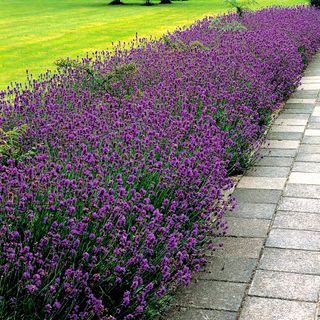
Munstead Lavender Heirloom Seeds
For an easygoing lavender that thrives in a large pot, pretty Munstead from Park Seed is ideal. Robust and low maintenance, this heady purple attraction will become a fast favorite for bees and butterflies.
2. Dwarf Bee Balm (Monarda)
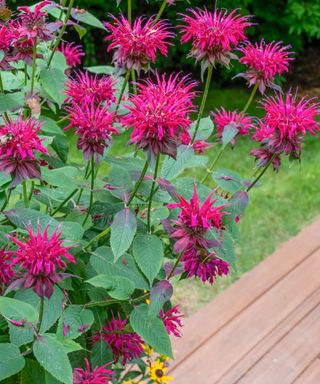
(Image credit: Janet Horton / Alamy)
Bee-friendly monarda can grow four feet high and across, and can spread fast, so it might not seem an obvious choice for compact plots and patio spots. However, you can grow dwarf bee balms specifically for the smaller sized potted pollinator garden. Notable examples include ‘Petite Delight’ and ‘Pardon My Purple’. Containers should be at least five gallons in size and placed in the sunniest spot you can find.
3. Milkweed
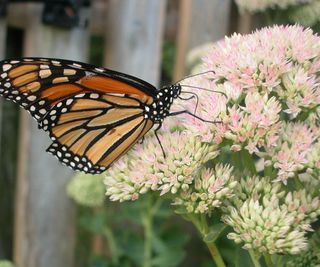
(Image credit: ReliableDesign / Getty Images)
Beloved of Monarch butterflies, milkweed is well known for its pollinating super powers. Still, although many of the showier varieties can reach several feet high, it is possible to grow milkweed in containers. Make sure you use sandy potting soil and a container with a diameter of ideally 16 inches (40cm) or more and a good drainage hole. Position on the periphery of other plants to attract your visiting pollinators.
4. Dwarf Coneflower

(Image credit: Shebeko / Shutterstock)
With their statuesque stems and impressive flower heads, echinacea can also seem like potential space-hoggers. But coneflower varieties such as ‘Lilliput Dwarf’, ‘Prima Ginger’, ‘Pixie Meadowbrite’ and ‘Guatemala Gold’ are only likely to reach 12-15in (30-40cm) tall and can happily flourish in compact spots. You just need to make sure that containers have ample drainage holes and that they are placed in full sun.
5. Yarrow (Achillea)
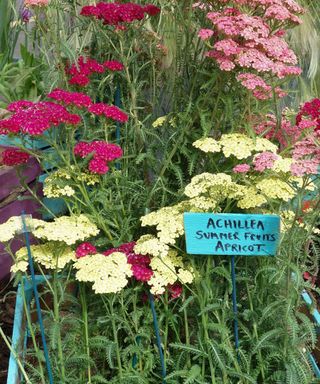
(Image credit: Peplow / Getty Images)
With their clouds of tiny fluffy flowerheads in shades from brilliant white through burnt orange and yellow to neon magentas, yarrow (Achillea millefolium) make dazzling pollinator plants in small spaces. Although some varieties climb to several feet high and across, miniature breeds like ‘New Vintage Violet’ are only 8-10 inches (20-25cm) tall. Perfect for a potted pollinator garden in full sun or partial shade.
Frequently Asked Questions
How do I Create Diversity in any Size of Garden?
When it comes to planting a pollinator garden, diversity is key. The best plants are those that produce an abundance of flowers, or that serve as host plants for specific pollinator species. Planting a vast range of annual and perennial flower types will help to prolong the bloom season, and make plantings more appealing to garden visitors. While vibrant shades of red, orange, pink and yellow are most common, fragrant blooms may also enhance their ability to attract pollinators to the space.
What Attracts Pollinators to a Small Space Garden?
Spring-flowering bulbs, hardy annuals, tender annuals and perennials can be mixed within containers and small flower beds (if you have them) to ensure that nectar is readily available to pollinators through the summer growing season.
Native flowering plants are often a good option, as many are considered to be highly adaptable. Interplanting and using pollinator plants in vegetable and herb gardens is also popular. Though you may be tempted to treat plants for insects like mites or aphids, it is imperative that a potted pollinator garden remains free of chemicals and pesticides.


